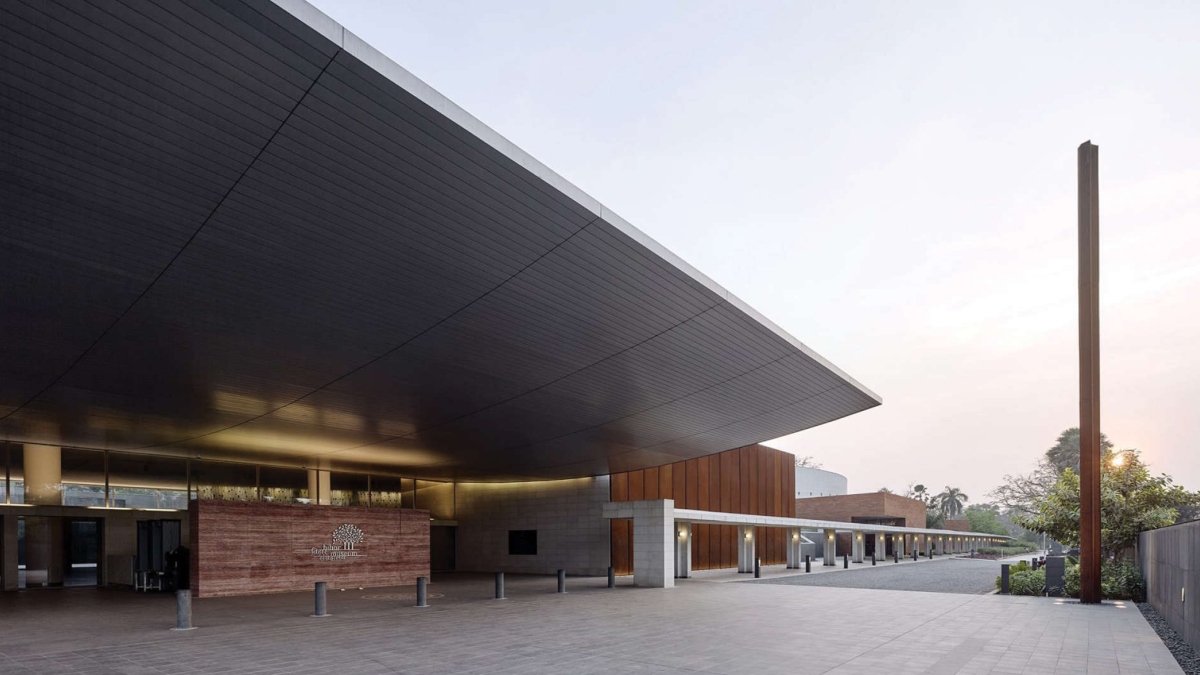
Overlooking the main artery of Patna, the grand Bailey Road, stands the magnificent Bihar Museum. The Bihar Museum, designed by the world-renowned architect Fumihoko Maki as part of Bihar Chief Minister Nitesh Kumar‘s vision for the development of civil society, is an iconic landmark that holds within it the many layers of the second historical urbanisation of India.
 Front view of Bihar Museum, Patna.
Front view of Bihar Museum, Patna. Dr Alka Pande
Dr Alka Pande Bihar Museum, Patna.
Bihar Museum, Patna.
Dr Alka Pande, art historian, author, member of the Bihar Museum Advisory, and Chief Curator of Women and Deities, shares the sheer historic richness of the museum and offers a glimpse into the forthcoming exhibition Women & Deities that will be unveiled on Foundation Day, 7th August. The centre of Imperial power, Patna, or Pataliputra, as parts of it were known in ancient India, continues to carry the grand condition of art, culture, and governance. Having been closely associated with the Bihar Museum, one of the finest examples of a giant home of culture, I would like to share an exhibition that I am curating, Women and Deities in the Bihar Museum. Consisting of 174 objects from antiquity, the mediaeval period, and contemporary times, the exhibition is a tribute to 2000 years of the representation of women through the ages. Nowhere in the world has a museum opened the coffers of its reserve collection to the public on such a scale. 166 objects consisting of Terracotta, bronze, stone, and paintings.
The Director General and Advisor to the Bihar Museum, Anjani Kumar Singh, as Chief Secretary of the State, single-handedly ensured the realisation of the dream and vision of the Chief Minister. Ever since Singh took over as the Director General in March of 2022, he has been populating the Bihar Museum with a steady and inventive scheme of programming. From art appreciation courses to exhibitions of artists from Bihar to now, this immense and significant exhibition on Women and Deities, “I believe that a magnificent building is not sufficient to keep alive the culture and heritage of a state. It has to be continually nurtured and fed with dynamic programming to keep it alive and vibrant. “In keeping with this philosophy, Singh is continually injecting the museum with a host of activities. A continuous hustle and bustle is seen the minute you enter the cool environs of this eco-sustainable building. The historical galleries, which showcase the wonders of Bihar, and the evolving Diaspora Gallery are a testament to the wonder that is Bihar.
The words of the First President of India are prophetic. If you know the history of Bihar, then you know the history of India. And these are the words that greet you the minute you enter the Orientation gallery. The museum cafe enriches the museum’s cultural ethos through its finger-licking array of the traditional cuisine of Bihar. The Museum Gift Shop, run by the Upendra Maharathi Institute, creates the most beautiful objects of art in a way that documents the intangible heritage of Bihar. The women and deities in the Bihar Museum are unique and significant in several ways. It shows the timeline of artistic representation of women through the last 2000 years and through these exquisitely sculpted figurines and paintings, the beauty, grace, and cultural identity of the women of the region.
The four materials which form the collection are also particular to the state. Terracotta and polished stone as materials were very much part of the Mauryan period, which flourished in and around Magadha and Pataliputra. The rich polish imparted to the Yakshi, her ornamentation, hairstyle, facial expression, and alluring smile add to the immense charm of the Didarganj Yakshi, the jewel in the collection of the Bihar Museum, not to forget the exquisite art by way of bronzes from Nalanda and Kurkihar, which flourished during the Pala period. In fact, two extremely significant things started in Bihar. In Vaishali where the first republic or oligarchy emerged, and Rajgarhia, where the foundations of the monarchy developed. The more I visit Bihar, the more I discover about the wonder that is Bihar and therefore India. My curatorial direction for this exhibition stems from years of my engagement with ancient Indian art history, culture, and heritage. It attempts to show the many manifestations of women in different materials, through different periods in time, and through different stylistic attributes.
The range of women in the arts of India spans a large cross-section of Indian society and culture. From princesses to heroines, from goddesses to devotees, the many forms and manifestations of the feminine form are celebrated in the exhibition. So much can be deduced and understood about the different aspects of Indian art, culture, and polity. Each artwork becomes a cultural bearer of the time and age in which it was created. I have dedicated this exhibition to the women of Bihar.